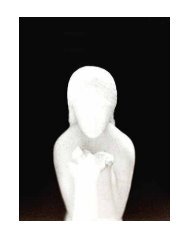Odds and Ends Essays, Blogs, Internet Discussions, Interviews and Miscellany
Collected essays, blogs, internet discussions, interviews and miscellany, from 2005 - 2020
Collected essays, blogs, internet discussions, interviews and miscellany, from 2005 - 2020
Create successful ePaper yourself
Turn your PDF publications into a flip-book with our unique Google optimized e-Paper software.
One example I keep coming back to is radically simple: ‘Bye Bye Love’, by The Everly Brothers. It’s so
banal, but anyone can identify with it:
There goes my baby with someone new
She sure looks happy I sure am blue
The power and popularity of such a song are a scandal for the kind of “empiricist”, “non-abstract”
poetics that you criticize (something I am willing to admit even though I pursue that poetics myself!).
Jane Holland
I don’t have the poem to hand, but is ‘November’ the poem about the funeral, where the “evidence” is hair still
caught in a hairbrush? S A [Simon Armitage] does this very well.
I understand the complaint about simplicity and transparency in the writing, but I think that does-like fictionallow
a space in the reader’s head to “imagine” what remains unsaid. For what it’s worth, I prefer S A when he
treads over less mundane territory, using metaphor and repetition to excellent effect.
Love it or hate it, Zoom was a milestone in contemporary poetry. Maybe not for the avant-gardists, but then, it
probably didn’t much interest train enthusiasts either.
Mark Granier
I love Dylan, Cohen AND Armitage. And all of these lyricists can be perfectly straightforward (some of Dylan’s
greatest songs are almost completely transparent: ‘Oxford Town’, ‘Hattie Carroll’, ‘Lay Lady Lay’, ‘Don’t Think
Twice’), but you’d hardly dismiss them as ‘prose configured into a rhythmic pattern’ [a phrase used by Side in one of
his essays]. No mention was made either of the lullaby tetrameter in Armitage’s poem, which gives it a more intimate
mesmeric music. He [Side] quotes [in one of his essays] Keats’s demand that poetry ‘should surprise by a fine excess,
and not by singularity’ [a quote from one of Keats’ letters, which Side cites in his essay], but it was Keats who
asserted that ‘we hate poetry that has a palpable design on us’, which puts paid to much of the post-advance rearguard
project. The Armitage poem Side sets out to diminish doesn’t have ‘palpable’ designs; it can be taken in like a
song. It works through imagery, mood, tone, atmosphere and rhythm, like a love song, like blues. And anyway, Side is
overlooking those poems by Armitage which do exhibit a ‘fine excess’, though again, the excess is in the mood,
imagery, etc.
Jeffrey Side
Mark, I agree to a point when you say ‘… ‘Lay Lady Lay’, ‘Don’t Think Twice’), but you’d hardly dismiss them as
‘prose configured into a rhythmic pattern’. But you also have to take into account that intermingled within his
[Dylan’s] more straightforward songs are lines that are general, non-specific and mysterious such as these from ‘Lay
Lady Lay’:
‘Whatever colors you have in your mind / I’ll show them to you and you’ll see them shine’
‘His clothes are dirty but his hands are clean’
And from ‘Don’t Think Twice’:
‘It ain’t no use in turnin’ on your light, babe / That light I never knowed / An’ it ain’t no use in turnin’ on your light,
babe / I’m on the dark side of the road’
I think you’ll find that most contemporary mainstream poetry would look upon such lines as inappropriately vague.
Andrew Shields
Jeffrey, I’m not sure about one of your examples: ‘His clothes are dirty, but his hands are clean’.
82




